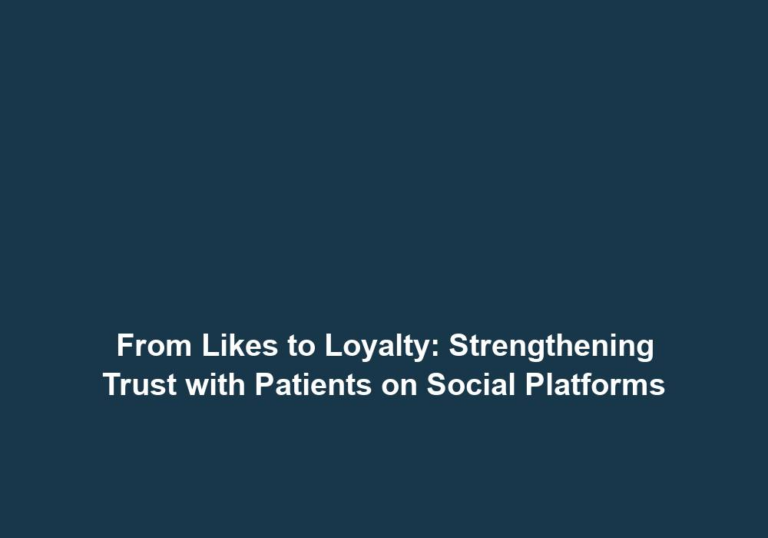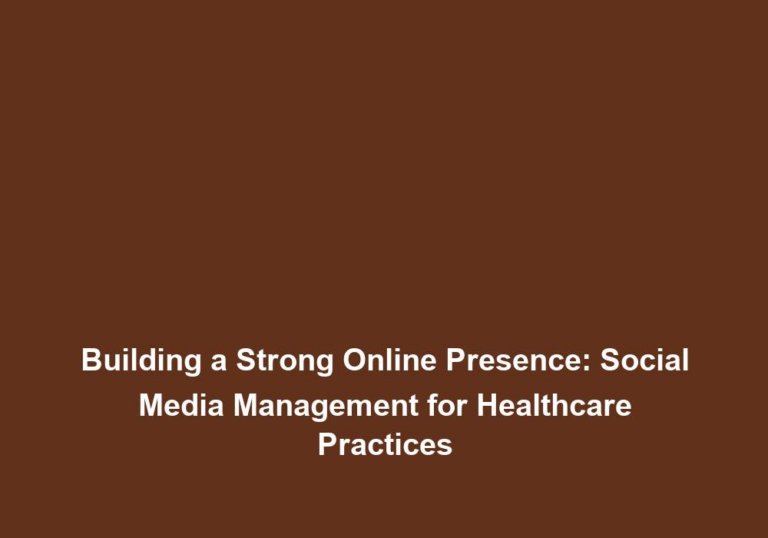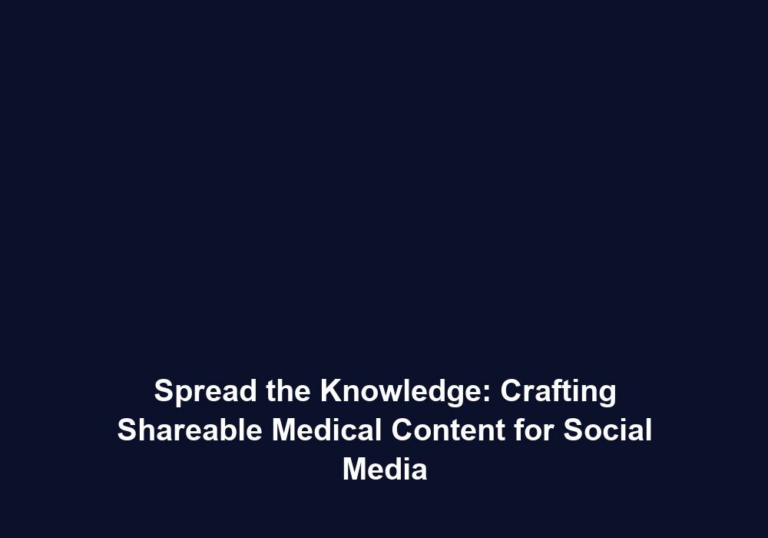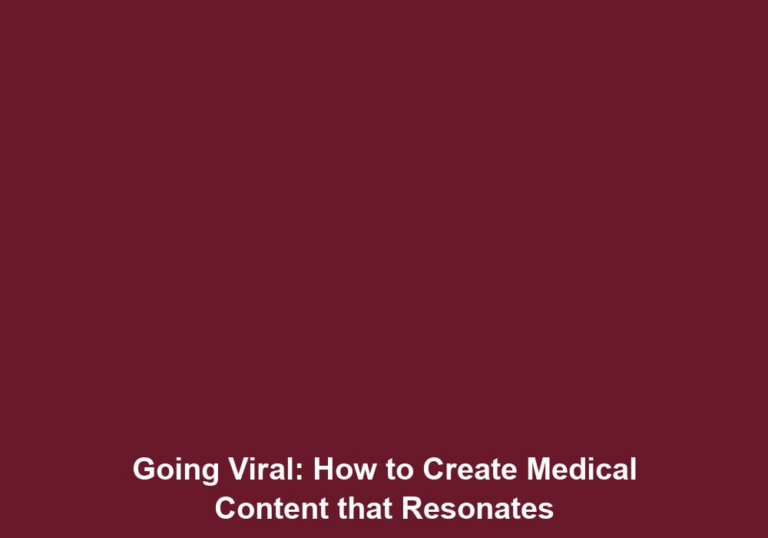Strengthening Online Bonds: Top Engagement Strategies for Healthcare Social Media
In the era of digital marketing, social media has become an indispensable tool for healthcare organizations to connect with their target audience. It not only provides a platform for sharing valuable information but also enables healthcare providers to engage with patients and build lasting relationships. Effective engagement strategies on social media can help enhance brand visibility, increase patient trust, and ultimately drive better health outcomes. In this article, we will discuss some top engagement strategies for healthcare social media, focusing on strengthening online bonds.
Utilize Storytelling to Connect Emotionally
Storytelling is a powerful tool that can help healthcare organizations connect with their audience on a deeper level. By sharing real-life patient stories or success stories, healthcare providers can evoke empathy and build emotional connections. These stories can highlight the challenges patients faced, the journey they embarked on, and the positive outcomes they achieved with the help of healthcare professionals.
Expanding on this, storytelling humanizes the healthcare experience and makes it relatable to the audience. It allows patients to see themselves in the narratives shared, fostering a sense of connection and understanding. By presenting authentic stories, healthcare organizations can build trust and credibility, ultimately strengthening the online bonds between healthcare providers and patients.
To further enhance engagement through storytelling, healthcare organizations can consider the following approaches:
- Diverse Perspectives: Share stories from different demographics, showcasing a range of experiences and ensuring inclusivity.
- Visual Elements: Incorporate images or videos to complement the narratives and make them more engaging.
- Patient Testimonials: Encourage patients to share their stories through testimonials, either in written or video format.
Foster Two-Way Communication with Patients
Engagement on social media should not be a one-sided conversation. To strengthen online bonds, healthcare organizations must encourage and actively participate in two-way communication with patients. This can be done by responding to comments, messages, and reviews promptly. Prompt replies show that the healthcare provider values patient opinions and is willing to address their concerns.
Expanding on this, effective two-way communication involves more than just responding to patient inquiries. It involves actively seeking feedback, initiating discussions, and creating a sense of community. Healthcare organizations can achieve this by:
- Prompt and Personalized Replies: Respond to patient comments and messages in a timely manner, addressing their specific concerns or questions.
- Active Listening: Monitor social media platforms for mentions of the organization and engage in conversations by offering insights or solutions.
- Live Q&A Sessions: Host live question and answer sessions where patients can directly interact with healthcare professionals and receive expert guidance.
Additionally, healthcare organizations can leverage online forums or webinars to foster interactive discussions and provide valuable information to patients. This interactive approach fosters patient engagement, builds trust, and enhances the overall online experience.
Create Educational Content to Empower Patients
One of the most effective engagement strategies in healthcare social media is the creation of educational content. By sharing informative articles, blog posts, infographics, or videos, healthcare organizations can empower patients with knowledge.
Expanding on this, educational content serves as a valuable resource for patients seeking information on various healthcare topics. It can cover a wide range of subjects, including disease prevention, treatment options, lifestyle modifications, and wellness tips. The key here is to provide valuable and accurate information in a user-friendly format.
To create impactful educational content, healthcare organizations can consider the following:
- Identify Patient Needs: Research and understand the information patients are seeking and tailor content to address those needs.
- Visualize Data: Use infographics or visual representations of data to make complex information more accessible and understandable.
- Collaborate with Experts: Seek input from healthcare professionals or subject matter experts to ensure the accuracy and credibility of the content.
Clear and concise educational content not only engages patients but also positions the healthcare organization as a reliable source of information. This, in turn, strengthens the online bond between providers and patients.
Embrace Visuals to Enhance Engagement
Visual content has proven to be more engaging and memorable than plain text. Healthcare organizations can leverage this by incorporating visual elements such as images, videos, and infographics in their social media posts.
Expanding on this, visual content captures attention and conveys information in a more compelling manner. It helps break down complex concepts, making them easier for patients to understand and remember. For instance, instead of sharing a lengthy article, a healthcare organization can create an infographic summarizing key points or statistics related to a health topic. Similarly, short videos can be used to demonstrate exercises, techniques, or interviews with healthcare professionals.
To effectively embrace visuals and enhance engagement, healthcare organizations can consider the following:
- Consistent Branding: Maintain a cohesive visual identity across social media platforms to establish a recognizable and professional image.
- Visual Storytelling: Use images or videos to tell compelling stories that resonate with the audience.
- Accessibility: Ensure that visual content is accessible to all users by providing alt-text or captions for images and transcripts for videos.
Visual content not only captures attention but also makes complex information more accessible and shareable, thereby increasing engagement and expanding the reach of healthcare organizations on social media.
Encourage User-Generated Content
User-generated content (UGC) can be a powerful tool for healthcare organizations to strengthen online bonds. By encouraging patients to share their experiences, testimonials, or success stories, healthcare providers can demonstrate social proof and build trust among their target audience.
Expanding on this, UGC serves as authentic and relatable content that showcases real experiences and opinions of patients. It fosters a sense of community and advocacy, as patients become actively involved in the conversation. Healthcare organizations can encourage UGC by:
- Hashtag Campaigns: Create specific hashtags related to a healthcare service or treatment and encourage patients to share their experiences using the hashtags.
- Contests or Challenges: Organize contests or challenges that encourage patients to participate and share their stories, offering incentives or recognition.
- Testimonial Features: Highlight patient testimonials on social media platforms, showcasing the positive impact of healthcare services or treatments.
Sharing UGC not only engages patients but also encourages others to share their experiences, further fostering a sense of community and advocacy among the target audience.
Leverage Influencer Marketing in Healthcare
Influencer marketing has gained significant popularity in recent years and can also be leveraged in the healthcare industry. Collaborating with relevant influencers, such as doctors, nurses, or healthcare professionals, can amplify the reach and credibility of social media campaigns.
Expanding on this, influencers bring their expertise and credibility, which can enhance the impact of healthcare organizations’ social media efforts. They can share their knowledge, promote educational content, and engage with their followers to create meaningful conversations. By partnering with influencers who align with their brand values, healthcare organizations can effectively reach their target audience, strengthen online bonds, and further enhance their social media engagement strategy.
To leverage influencer marketing effectively, healthcare organizations can consider the following:
- Identify Relevant Influencers: Research and identify influencers who are respected and trusted within the healthcare industry.
- Establish Authentic Partnerships: Collaborate with influencers who align with the organization’s values and mission, ensuring authenticity in the partnership.
- Engage in Meaningful Conversations: Encourage influencers to actively engage with their followers by responding to comments and questions related to the healthcare organization’s content.
By leveraging influencer marketing, healthcare organizations can tap into established communities, gain credibility, and expand their reach on social media platforms.
Conclusion
In conclusion, healthcare organizations can strengthen online bonds and improve engagement on social media by implementing effective strategies. Utilizing storytelling, fostering two-way communication, creating educational content, embracing visuals, encouraging user-generated content, and leveraging influencer marketing are all powerful strategies to connect with patients and build lasting relationships. By investing in a robust engagement strategy, healthcare organizations can enhance brand visibility, increase patient trust, and ultimately drive better health outcomes in the digital age.







